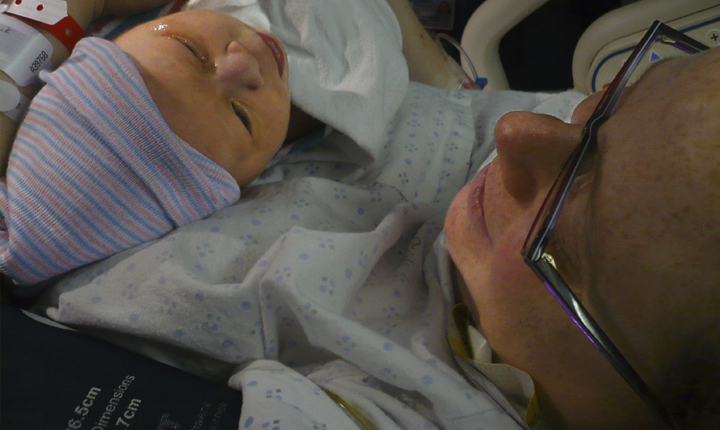The Longest Shortest Time
EPISODE #27: Rewriting Your Birth Story
This is Part 1 of a three-part series on Natural Birth. Click here for Part 2 and Part 3.
Like a lot of first-time moms, I hoped for a natural childbirth. And I did everything I could think of to give myself the best chances of having one: I got a midwife, read Ina May Gaskin, took prenatal yoga. In the end, things went pretty awry. So awry that I came out of childbirth with PTSD, horrific flashbacks, and pain that persisted for the next three years. And I wound up wondering obsessively: Could I have done anything differently to make things less traumatic?

Me meeting Sasha for the first time, after 25 hours of labor, including an IV drip, Pitocin, an epidural, an oxygen mask, a catheter & an episiotomy
I had questions for my midwife. Lots of questions. And I wanted to ask them face to face. So we drove down to see her at Pennsylvania Hospital, where we were met with an out-of-the-blue snowstorm. Which was so weird, because is was snowing like that the last time we drove to that hospital—the day Sasha was born.

Philly when Sasha was born

Philly 4 years later
In this episode, I get my questions answered—both by my midwife and by maternal care researcher Saraswathi Vedam, who tells me something that will forever change the way I tell myself my birth story.
Resources for Choices in Childbirth
If you’re pregnant and hoping for a birth with as few medical interventions as possible, I encourage you to check out the resources below. If you’re like me and you wanted a normal birth and didn’t get one, these resources may answer some of your lingering questions.
Survey. Listening to Mothers is a periodically conducted survey, which collects data on women’s experiences and attitudes toward pregnancy, childbirth, and maternal care. If you’re interested in learning more about the rate of different types of interventions, how they’ve changed over time, and how women feel about those interventions, these surveys are a fascinating read. You can see a summary of the most recent survey’s major findings here.
Studies on intervention. In this story, I mention a study by the American Congress of Obstetricians & Gynocologists stating that cesarean is overused on first-time, low-risk moms. You can read that report in Safe Prevention of the Primary Cesarean Delivery. This review from Cochrane Libraries and this study from the American Journal of Obstetrics & Gynecology examine the adverse effects of epidural on mom and baby. If you’re looking for research on Pitocin, this study from BMJ finds a significantly higher risk of severe postpartum hemorrhage with the use of Pitocin in labor, and this one from Obstetrics & Gynecology finds that elective induction significantly increases the risk of C-section in low-risk women.
Studies on place of birth. If you’ve ever tried to get a straight answer on where it’s safer to have a baby, hospital or home, you will find that the existing studies are confusing and conflicting. Saraswathi Vedam, who I interview in the piece, has evaluated the research for quality and veracity, and she has compiled a list of the best available data in her paper Home Birth: An annotated guide to the literature. Several of the studies she cites—this one from Cochrane Database of Systematic Review, this one from BMJ, this one fromBJOG: An International Journal of Obstetrics & Gynaecology, this one from the Canadian Medical Association Journal, and this one from the journal Birth—suggest that planned home birth with a qualified attendant and planned hospital birth are equally safe, when it comes to low-risk pregnancies in high resource countries. The caveat is, hospital births come with more frequent medical interventions.
Book. And if you’re looking for a book with a straightforward explanation of normal, physiologic birth, check out Immaculate Deception II by Suzanne Arms. It’s a classic that has held up.
Have you managed to revise YOUR birth story? Tell us how in the comments.
The Longest Shortest Time may earn a small commission from products linked on this site. Using our affiliate links helps support our work.